» Site Navigation

0 members and 1,037 guests
No Members online
Most users ever online was 47,180, 07-16-2025 at 05:30 PM.
» Today's Birthdays

» Stats

Members: 75,945
Threads: 249,146
Posts: 2,572,383
Top Poster: JLC (31,651)
|
-
Registered User


Re: Thoughts on culling...when and/or when not to?
 Originally Posted by Homegrownscales

I dont 100% percent agree with that. The definition of culling:
cull (kl)
tr.v. culled, cull·ing, culls
1. To pick out from others; select.
2. To gather; collect.
3. To remove rejected members or parts from (a herd, for example).
n.
[b]Something picked out from others, especially something rejected because of inferior quality.[b]
[Middle English cullen, from Old French cuillir, from Latin colligere; see collect1.]
Focusing mainly on this, since I piped up only for the fact part and not the opinion (which is yours and completely fine to have :3 )
Definition of CULL
transitive verb
1
: to select from a group : choose <culled the best passages from the poet's work>
2
: to reduce or control the size of (as a herd) by removal (as by hunting) of especially weaker animals; also : to hunt or kill (animals) as a means of population control
— cull·er noun
Really depends on context. When done to livestock (why would you kill off healthy animals that fit standard instead of letting them grow to be eaten or sell them off?) or pet mammals, it's the removal of weaker and non-standard genes from the breeding pool. In livestock, that usually means death (why waste resources on animals that will not give max production?). In pet mammals, if they can survive, it usually means spay/neuter asap and rehome to a pet-only environment. Some breeders will kill the nonstandard pups, but that is becoming a lot rare due to the popularity of the spay/neuter cull instead. In animals that are hunted, culling is population control for things such as deer, wolf, and feral pig populations. Again, it might be different in the context of reptiles, but outside of that culling is not just people killing off healthy animals just to create a pretend limited resource.
Last edited by Jazi; 03-25-2012 at 09:45 PM.
1.0 Normal Ball Python (Quetzal)
0.1 Spotted Cream Tabby, Moggie (Saffron)
-
-
We're talking about culling in the common useage sense of the word, not Webster's. Common useage for the the term culling in this hobby means sticking a snake in the freezer, and has for a long time. Plain and simple. Why a breeder chooses to do it (or not) is still up the individual.
Thomas "Slim" Whitman
Never Met A Ball Python I Didn't Like 
-
The Following User Says Thank You to Slim For This Useful Post:
-
Comparing culling in livestock versus pet trade animals are 2 totally different things. Now putting down unhealthy animals is abother different story. Yes if an animal is produced unable to survive then it needs to be put down. Culling for the better of the herd to provent population blooms and the spread of disease or malnutrition due to such population blooms is what i think of in culling. We cull the deer herds on my parcels of lands to ensure a healthy herd and healthy herd numbers as well as healthy sex ratios. Now thats what culling is. My responses are based off the original point of breeders killing totalky healthy bavies just because they cant handle the amount of normal animals they produce as a biproduct of their breedings. This is not culling.
[IMG]  [/IMG]
-
-
Re: Thoughts on culling...when and/or when not to?
 Originally Posted by snake lab

breeders killing totalky healthy bavies just because they cant handle the amount of normal animals they produce as a biproduct of their breedings. This is not culling.
What do you call it?
Thomas "Slim" Whitman
Never Met A Ball Python I Didn't Like 
-
-
Re: Thoughts on culling...when and/or when not to?
 Originally Posted by snake lab

My responses are based off the original point of breeders killing totalky healthy bavies just because they cant handle the amount of normal animals they produce as a biproduct of their breedings.
That was not the original point whatsoever nor anywhere near my thought process...that came in somewhere else along the line.
-
-
Registered User


Re: Thoughts on culling...when and/or when not to?
 Originally Posted by snake lab

Comparing culling in livestock versus pet trade animals are 2 totally different things. Now putting down unhealthy animals is abother different story. Yes if an animal is produced unable to survive then it needs to be put down. Culling for the better of the herd to provent population blooms and the spread of disease or malnutrition due to such population blooms is what i think of in culling. We cull the deer herds on my parcels of lands to ensure a healthy herd and healthy herd numbers as well as healthy sex ratios. Now thats what culling is. My responses are based off the original point of breeders killing totalky healthy bavies just because they cant handle the amount of normal animals they produce as a biproduct of their breedings. This is not culling.
And I gave examples of the different meanings of pet trade, livestock, and game animal culling in my posts, speaking to how it was different and how population control is not the only reason for culling nor is it the only definition. A baby snake that's kinked from head to tail and unable to eat would be culled; that's not a healthy animal killed for ratio control, it's protecting the breeding stock and saving everyone a lot of heartache in the process. You're right, killing off normals just because a breeder didn't have the foresight to expect them isn't actually culling, it's just someone being lazy and not wanting to deal with what they're producing. Culling is done to domesticated animals to keep bad breeding stock out of the gene pool, not to control populations, which gets back to my point :S
Should a baby snake with just a little kink in the tip of its tail be culled despite it being healthy otherwise? That's the point of the topic being discussed, I thought. And as my original post said, in the pet mammal world, the answer would be yes, though most breeders would opt to spay/neuter-cull instead. However, as I said, because the reptile world hasn't adopted the strict standards and politics that the mammal world seems to adore and embrace, that decision is left to the breeder and buyer.
1.0 Normal Ball Python (Quetzal)
0.1 Spotted Cream Tabby, Moggie (Saffron)
-
 Posting Permissions
Posting Permissions
- You may not post new threads
- You may not post replies
- You may not post attachments
- You may not edit your posts
-
Forum Rules
|









 Reply With Quote
Reply With Quote

 [/IMG]
[/IMG]